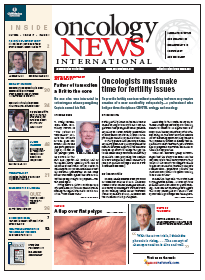Oncology News: International steps out with a new look, and a new approach
With this issue, regular readers of Oncology News International will notice a new look to the publication. We’ve introduced a new design that we believe is cleaner, more functional, and more appealing to the eye than what we’ve used in the past.
With this issue, regular readers of Oncology News International will notice a new look to the publication. We’ve introduced a new design that we believe is cleaner, more functional, and more appealing to the eye than what we’ve used in the past.

The new design caps a series of changes we’ve been making to Oncology News International, all of them intended to keep you, our readers, engaged and better informed about important developments in the cancer care community.
We’ve preserved the best elements of our past coverage, particularly clinical trial and study coverage from meetings and a section devoted to policy and practice, but at the same time we have expanded our approach to include a more issue-oriented look at the clinical and economic forces that are driving the advancement of hematology and oncology.
Working with our editorial advisors and our editor-in-chief, Steven Rosen, MD, we’ve come up with several new features in the publication. We’ve also been guided by surveys of our readers.
“We hope that the new format will appeal to our readership and allow for critical information to be presented in an effective manner,” Dr. Rosen said.
Besides the design changes, you’ll find:
• A regular point-counterpoint feature that examines a topical clinical controversy in cancer care.
• A monthly profile-Masters of Hematology and Oncology-that explores the lives of those who have contributed significantly to your profession.
• A greater focus on international developments in hematology and oncology.
• More analysis and perspective that explains the topical events in hematology and oncology.
• More attention to the people-your colleagues-who are helping shape the practice of hematology and oncology.
We believe our new design better highlights these changes and presents them in a way that is more readable and easy to understand.
While we are off to a good start, we know there is more to do, and we would like to hear your ideas and suggestions. It doesn’t matter if it’s a people item, an idea for an article, or a criticism; we want to hear it.
Please send comments to me at john.hayes@cmpmedica.com. Alternatively, if you know any of our editorial advisors, please share your thoughts with them. With your help, we can make Oncology News International an even stronger publication.